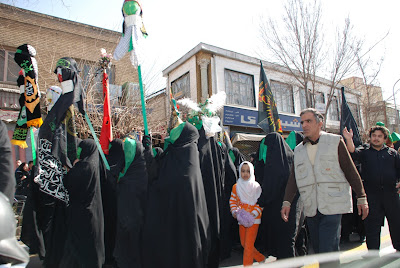Salaam,
The age-old city of Qazvin is established in a wide land with a background of ten millennia of dwelling place and contained in itself a great deal of eminent works that belong to the far millennium. This city enjoyed a special place in the Safavid era and was the capital of the empire of Safavid Shi’ite. A former capital and a prosperous town, Qazvin was a flourishing center of civilization during the Sassanid era that lasted five centuries.
On Sunday, 15 April 2007, the ASEAN Ladies Circle (ALC) of Tehran organized a one-day trip to the city of Qazvin. The city is located about 120 km west of Tehran, and it took us about two hour’s bus ride to arrive there at 9.00 in the morning.
Qazvin is regarded an important historical site. In addition to the relics of Sassanid era, it boasts of Safavid buildings made a century before the development of Isfahan as the capital of Iran.
Upon arrival, we first had our Iranian breakfast at Alborz Hotel Restaurant in the city center. After greeting, welcoming and a short briefing by our local guide who also accompanied us from Tehran, we began our tour of the city with a visit to the Chehelsotoon Palace.
Chehelsotoon Palace, also called Kolah Farangi, is one of the significant Safavid monuments of Qazvin, located in the center of a large garden, and now serving as the city’s museum. It was the model for the Hasht-Behesht edifice in Isfahan. Chehelsotoon is a two-storey building in whose chambers some relics belonging to different period, including the Safavid epoch are on exhibition.
From Chehelsotoon, the group then walked to the covered Bazaar Qazvin. The numerous caravanserais and corridors of the traditional bazaar of Qazvin are among the most spectacular sites of the city, with its interesting old architectural designs. In different parts of the bazaar, there were some mosques, bath houses and Qeisarieh.
Like many other cities in Iran, the mosques of Qazvin are among the most valuable and spectacular buildings. These include the Jame’ Atiq mosque built at the order of Haroun, the Abbasid caliph, in the 7th century AD, and Sardar Mosque and seminary school built during the Qajar era in the 19th century.
The stately domes, minarets, portals, doors, windows and exquisite tile works of Haidaiyyeh, Al-Nabi, Sanjideh and Salehiyyeh mosques and seminary school really attracted our attention.
For lunch, we were served with a local food of Qazvin called “Qaymeh Nesa” at one of the traditional restaurants in the city.
For lunch, we were served with a local food of Qazvin called “Qaymeh Nesa” at one of the traditional restaurants in the city.
The next itinerary in our program was a visit to Sardar Cistern on the eastern side of Rah Ahan (railroad) street. Qazvin has some of Iran’s best-preserved and most impressive domed cistern. More than a hundred underground water reservoirs were built in Qazvin during frequent bouts of draught. The structure of the reservoirs and materials used in them make every visitor wonder about the mastery of its architects. The founder of this cistern was two brothers and great warriors of Fath Ali Shah of qajar dynasty.
Apart from the few sites we managed to visit above, there were many other fascinating and historical places in and around Qazvin. However due to the time constraint, we had to return back to Tehran according to the time schedule.
One of them is the shattered remnants of over 50 mountain fortresses or castles, most notably of which is the Alamut castle. It’s another world from the city but just about 30 to 80 km away, situated at the foot of the central Alborz mountain range. In the 11th century the Ismaelite movement known as the Assassins controlled the area under the legendary leadership of Hassan Sabbah, popularly known as “the Old Man of the Mountain.” They were finally overcome during the Mongol invasion in 1256 AD.
Insya Allah, when time opportune, we hope to return back to this legendary lands…the land of all seasons.
Wassalam.
 breakfast at Alborz hotel restaurant
breakfast at Alborz hotel restaurant
 beautiful wood-framed colored glass windows of Chehelsotoon
beautiful wood-framed colored glass windows of Chehelsotoon 





















































